Brenda used to say this phrase often when the boys were young, and especially when they first got their driver’s licenses! I can’t say that I always agreed with her, but aboard Pandora when I am on passage, that often seems to be the case.
Before I get into all that, I should note that we have made, according to the chart, an average of 190 miles each day over the bottom since clearing Falmouth Harbor. That’s pretty good and takes into account a slow start as we dealt with the bad batten pocket in the first few hours of our trip, as well as the mess that we ran into yesterday that I’ll recount shortly. That’s pretty good time and has taken us 1/3 of the way home in only three days. I expect that our speed will be a lot less than that beginning tomorrow when the wind is expected to go light for a few days as we sail a lot faster than we motor.
All and all, we are making good time. At this point, the big question is if we can time our arrival at the Gulf Stream to avoid the NE winds that are forecast to be there late Sunday. For those who have crossed the Stream, you don’t want to be there when the wind direction has an “N” in it. However, as Chris Parker says, “that’s a long way off and things may change.”
Those of you who follow this blog will note that I did not post yesterday and if you didn’t notice, well, I didn’t post yesterday. I was licking my wounds, both figuratively and literally, and thought that it would be best to “sleep on it” before putting my thoughts down.
For clarity, it’s early on Wednesday morning and the sun is just peaking up over the eastern horizon as I sit down to do this post. Conditions are just about perfect with us broad reaching in 20kts of wind with a single reef in the main and the small jib. Our course is due north and the wind is from the southwest. As today progresses, we expect that the wind will continue to clock toward the south and lighten so I expect that by this time tomorrow we will be motoring.
There’s a front that is supposed to exit the east coast later this week that will bring adverse winds to the area where we will cross the Gulf Stream over the weekend so we are watching this carefully. I have had pretty good luck hearing Chris Parker in the evenings but not early in the day as I am used to. The propagation hasn’t been good for the SSB and even getting my simple emails has been a chore. If today is any different, I expect that this post won’t be sent to Brenda until sometime this evening. If not, that will be an improvement as I have not had any luck during the normal daylight hours. This has primarily been because the favored stations that I link to with the SSB email from this area are in Panama and Trinidad have been very busy with other traffic, a problem that I have found to be the case in past years. Later in the day and evening I find that the Lunenburg, and Rock Hill ,North Carolina, stations seem to work well and they are generally not that busy.
Anyway, I didn’t feel like writing yesterday but I am better now so here goes. Better late than never.
At midnight on Monday morning I was down below filling in the log of our location, speed etc. that I keep on all our voyages and suddenly Bob, who was on watch, shouted “the main is down, the main is down, put on your gear and get up here”. Bob is not prone to overstatement so I knew that something bad had happened.
I came up to see that the entire mainsail was draped over the cabin top and Bob and George were working feverishly to secure it before it was damaged. Not to put too fine a point on it but the damage had already been done as the fitting that attaches the sail to the main halyard had failed and shot up to the top of the mast so there was nothing at all keeping the sail up, so down it came in a heap.
So, here we were, in the middle of nowhere, some 600 miles south of Bermuda and hundreds of miles from anywhere — with no mainsail. The sailing conditions were perfect and we had been blasting along at sometimes double digit speeds with about 20kts on the beam and a single reef in the main. Of course, all of this had to happen the day after I wrote about our 200 mile day. Actually, we have had a number of them so far and to loose the main under perfect conditions was doubly upsetting.
I started the engine and was disappointed to hear massive vibration in the propeller. Isn’t that priceless? I expected that it had caught something like kelp or perhaps a piece of floating line on the prop. Whatever it was, there was no motoring and it wouldn’t clear. I searched in the engine compartment to see if perhaps there was another cause for the vibration and discovered that a shaft bearing, universal coupling was very loose because the bushings had deteriorated. In spite of keeping a careful eye on the engine, somehow I had missed that. So, I tinkered with the bushing for several hours and finally had it adjusted and while the bushings were still bad, I was able to get it into alignment and back in reasonable condition. I had never paid attention to this piece of gear, so when I noticed that it was getting pretty hot a while later, I didn’t know if that was normal or a problem. Fortunately, I have a laser thermometer and with that I was able to monitor various parts of the bearing to see if the temperature readings were changing. They continued to go up as the engine ran but finally stabilized and it didn’t seem to be too hot to me. Problem solved, well, sort of as the vibration in the shaft was still more than I would like.
After a few stops and starts with the engine in both forward and reverse, I was finally able to clear whatever was on the prop and the vibration smoothed out. We were back in business, if you don’t take into account that our primary sail was out of service and that we had with 600 miles to go to Bermuda. I really didn’t want to head there under power alone with no backup sail. Additionally, the sailing conditions were perfect and I didn’t want to give up on that.
Since it was the middle of the night, I went to bed with the hope that things would seem clearer by morning.
We all arose early the next morning and talked about what to do. I had awakened with a strong sense that we needed to repair the main, as aside from the head board separating from the sail, the sail was in good shape. The problem, and it wasn’t a small one, was that the headboard was now over 61′ in the air at the top of the mast, the wind was blowing at 20kts and the seas were in the 7-9′ range.
So, the decision… Go up the mast in the bosun’s chair and bring it down. Bob said it simply: “It’s just a go and grab job”. Go up the mast, grab the slide and bring it down again. Easy for him to say and he was right– well, sort of.
The problem is that it’s tough enough to walk around on deck or down below in a seaway but the higher up the mast you go when it’s rough, the more violent the movement becomes the higher up the mast you go. A few feet of movement near deck becomes a wild whipsaw at the top of the mast.
After the decision was made to run up the mast, we stopped to work out the details. Bob would work the main winch (fortunately electric) from the cockpit and use the spare spinnaker halyard to hoist me. George would work an additional spare halyard to pull up by hand to act as a safety line in the event that the main hoist line broke.
I got in the bosun’s chair, which I have used many times in calm conditions, with good results. It’s pretty secure, but I also put a sail tie around my chest, just in case I might get forced backward in the chair. I also put on my inflatable vest and foul weather jacket with the hope that the extra padding would provide some modest protection from getting banged up. Additionally, I used the long lanyard to my harness to run around the mast as I went up, in case I might lose my hold on the mast, a decision that turned out to be a very good one.
The boat was pitching pretty hard in the 7-9′ seas and the 20 kt winds and without the main to stabilize the boat, the small jib was all that I had to rely on and it only somewhat moderated the role and pitching of the boat.
I’ll say that I was very nervous about all that, but up I went. As Bob pulled me up the mast, with George taking up the slack with the safety line, I clung onto the mast like a koala bear hugging a tree. In spite of this, I still felt like I was going to be plucked off at any moment.
I had made the decision to wrap my safety strap around the mast as I went up but that proved to be much more difficult than I expected since I was forced to unhook it at each set of spreaders. For the few moments that I was unhooked, I was very vulnerable to loosing my grip on the mast. I also found that Bob could not hear me at all over the noise of wind and waves, so I had no option but to use hand signals, again taking one hand off of the mast.
The higher I went, the more the mast whipped around, threatening to break my grip. Twice I lost hold on the mast and swung out, jerking back on the tether, and banging back against the mast. George said that I looked like a fish on a lure, thrashing about as the mast whipped from side to side. I was terrified and could only think about the scene in the movie “The Martian,” when Matt Damon was being retrieved by another astronaut and was violently whipped around, enduring tremendous centrifugal forces, powerless to control his movement or save himself.
I finally worked my way up to the top of the mast and a few times I froze, unable to move my hands and legs, clinging to the mast. Finally however, I was there, at the mast peak, as was the headboard.
I worked it down the track, pulling a few feet of halyard with each movement trying to get it back down so George could secure it to the boom. Finally, it was down.
So now, to get back down to the deck. The trip back down was even worse than the trip up, since I was exhausted and my adrenalin was just about used up. And, to make matters worse, I had to stop at each spreader, unclip my harness lanyard and reattach it below for the run to the next spreader. While the movement of the mast was less the closer I got to deck level, I was really beginning to loose my nerve. By this time I was also pretty banged up from the two times that I lost hold of the mast on the way up and was jerked around by the whipping mast.
As far as holding on, I generally did pretty well except when a particularly large wave hit the side of the boat. As a rule, whatever the sea state, there will be the occasional wave that will be half again larger than the average and when one of these hit, I felt like a fly being flicked off of a branch.
The only thing that I did wrong in with my planning, with the possible exception of deciding to go up in the first place, was that I had opted to clip around the mast as opposed to the safety line that had a clear run down the front of the mast. Once I was up there, I realized that if I had been badly hurt, Bob and George would have had no way to get me past the next set of spreaders. And even now, the thought of that makes me shake.
When I finally got back to the deck I was just exhausted and could barely make my way back to the cockpit, even with George holding my arm for support.After a short time for regaining my composure, we sat down to consider how to fix the problem and get the sail ready to be re-hoisted. The damage to the top of the main was fairly straightforward.
The top of the main was strongly reinforced and was attached to the headboard with three web straps. Over time these straps had chafed through and ultimately failed. This is something that I never noticed. Now I will, that’s for sure. The fix we decided on, since we did not have a sewing machine, was to drill a series of nine holes in the heaviest part of the sail top and thread a series of Dynema 3/8″ rope strands through these holes and the slots in the headboard to secure the sail to the headboard. After several hours of drilling and threading we had things in good shape with each knot fully seized with waxed sail twine and we were good to go.
It’s not all that pretty (I’ll be posting some photos of all this when I get home next week) but very strong. Each piece of the Dynema that we used could easily support the weight of a car and has the added benefit of being very chafe and UV resistant.
So, as I write this the “new rig” is up and has been working well for 24 hours– and we continue to reel off daily runs of near 200 miles.
All and all, I think that we made the right call for me to go up the mast, but I have to say that for much of yesterday all I could think about was what “could have happened.” Oh yeah, you’d be amazed at the bruises that I have on the inside of each thigh and on the insides of my arms, from clutching the mast. I also have a few bruises from when I was slung around after losing my grip. It just goes to show how much you can accomplish with enough adrenalin.
So, as Brenda says, nothing good happens after midnight. and for once I have to agree when the sail came down in a heap. The “fix” was a harrowing experience, but the good news is that it all worked out and now I have a story to tell– and tell it I will.
Perhaps in closing I should also note what I wished I had done differently. First, I would have used a shorter safety line to the mast and would have secured it around the safety halyard and not the mast. That way I would not have had to leave myself vulnerable when I had to remove the line to get it past each set of spreaders. Also, I am going to put a helmet onboard as well as a climbing break, a tool that you slide up and down the safety rope, that would have secured me more effectively when I was plucked from the mast as well as if the main lift rope had failed. Of course, I could also say that I will NEVER again go up the mast in a seaway. However, never say never. Things can often look a lot different when you are hundreds of miles from land.
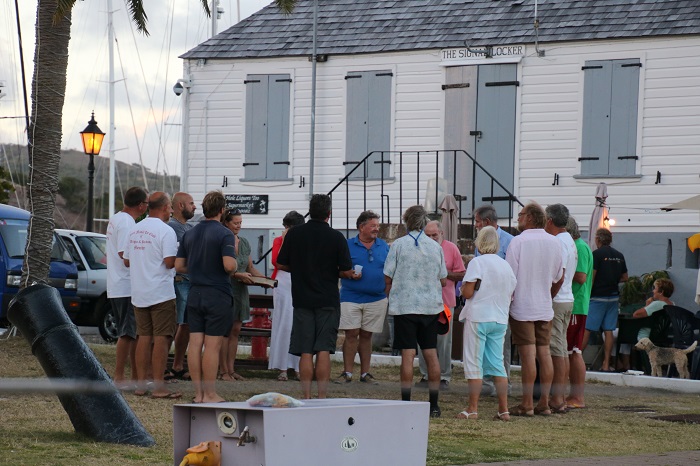 The group has met each day since july 31st, 1991 to carry on the tradition, ended on July 31st, 1970, of the British Navy of issuing a “tot” of rum each day and making one of seven proscribed daily toasts along with a toast to the Queen.
The group has met each day since july 31st, 1991 to carry on the tradition, ended on July 31st, 1970, of the British Navy of issuing a “tot” of rum each day and making one of seven proscribed daily toasts along with a toast to the Queen.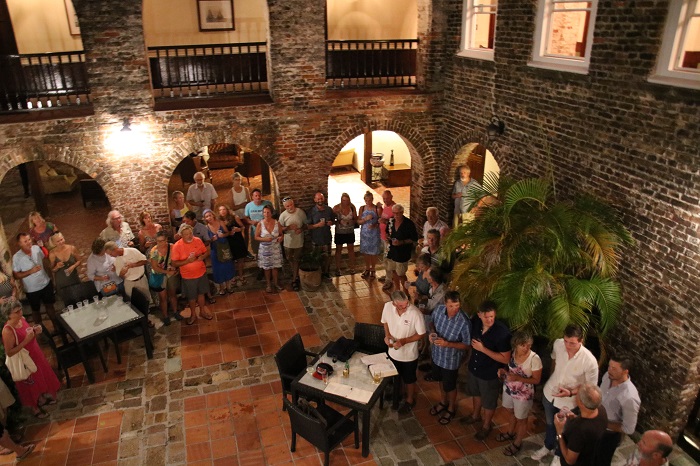 Of course, I was really taken by the club, the tradition and the great folks that are members and just had to join. The problem is that in order to join you have to commit to taking seven tots over a 14 day period and, on top of that, have to memorize all sorts of facts about Lord Nelson and his battles. Yes, I am repeating myself as I have written about all this in a number of past posts but bear with me on this. If you feel compelled to read ALL of these posts, go to the search window and type in “Tot Club”. It’s that easy…
Of course, I was really taken by the club, the tradition and the great folks that are members and just had to join. The problem is that in order to join you have to commit to taking seven tots over a 14 day period and, on top of that, have to memorize all sorts of facts about Lord Nelson and his battles. Yes, I am repeating myself as I have written about all this in a number of past posts but bear with me on this. If you feel compelled to read ALL of these posts, go to the search window and type in “Tot Club”. It’s that easy… The club was also hosted, twice, aboard an 80′ Oyster by a member, another spectacular venue.
The club was also hosted, twice, aboard an 80′ Oyster by a member, another spectacular venue.  And, another event at a home overlooking Falmouth Harbor. What a view.
And, another event at a home overlooking Falmouth Harbor. What a view. 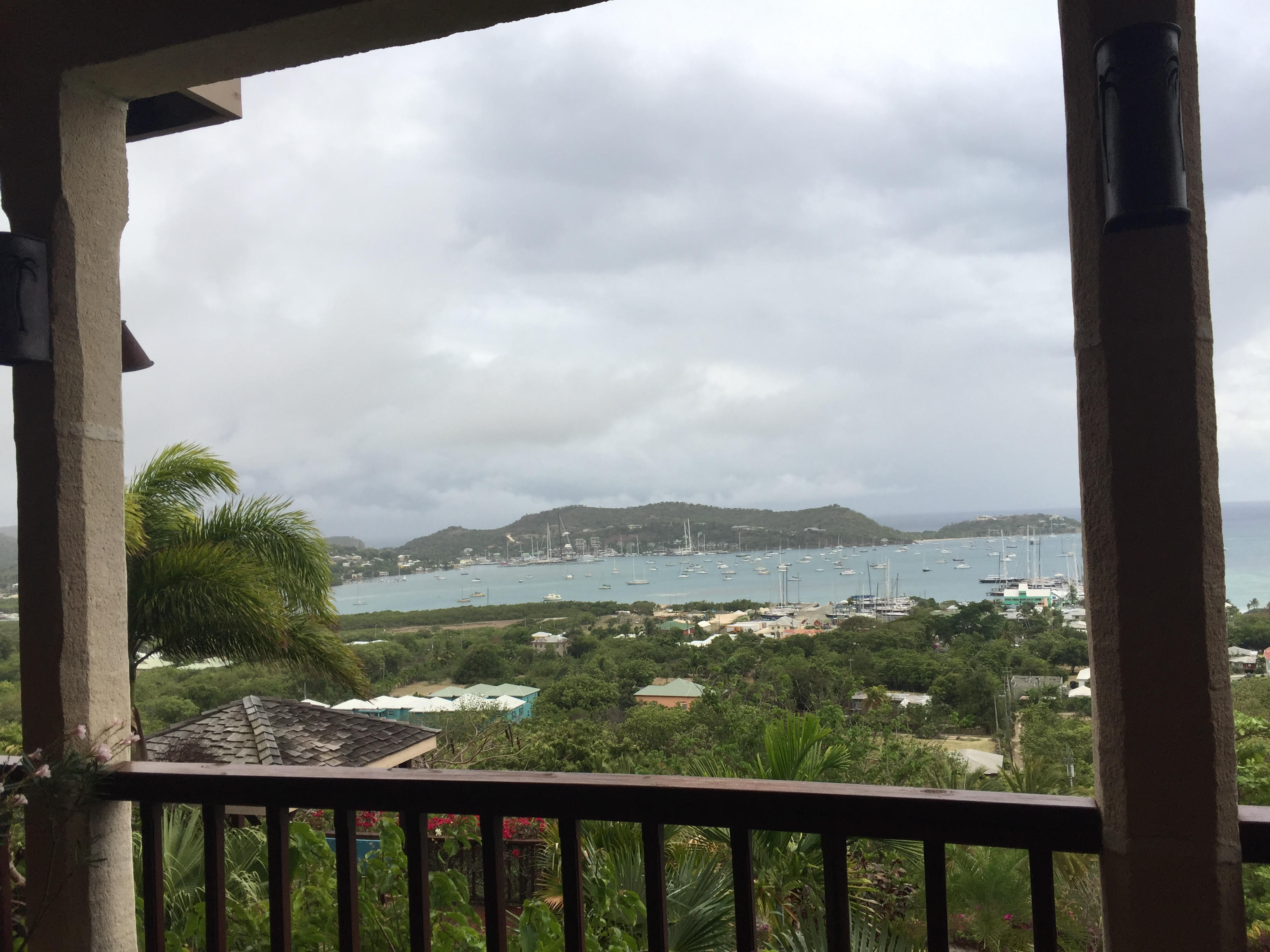 So, after 8 days and more tots than I can count, or remember, I took my test and passed. And, let me tell you, I would not have passed if it weren’t for the help of Simon, a member that took nearly a half day to tutor me on the finer points of club and British Navy history along with facts about the various battles that Lord Nelson was involved in.
So, after 8 days and more tots than I can count, or remember, I took my test and passed. And, let me tell you, I would not have passed if it weren’t for the help of Simon, a member that took nearly a half day to tutor me on the finer points of club and British Navy history along with facts about the various battles that Lord Nelson was involved in. As well as Ann, my sponsor, and her husband and one of the founders of the club, Mike. If it weren’t for them I would not be a member.
As well as Ann, my sponsor, and her husband and one of the founders of the club, Mike. If it weren’t for them I would not be a member.  I am looking forward to the arrival of the Salty Dawg Rally to Antigua next November and, as “Antigua Port Captain, the opportunity to introduce rally participants to The Royal British Navy Tot Club of Antigua and Barbuda. Just try saying that three times fast after a ” full measure”. And, believe me, that’s way easier than memorizing all that Nelson lore.
I am looking forward to the arrival of the Salty Dawg Rally to Antigua next November and, as “Antigua Port Captain, the opportunity to introduce rally participants to The Royal British Navy Tot Club of Antigua and Barbuda. Just try saying that three times fast after a ” full measure”. And, believe me, that’s way easier than memorizing all that Nelson lore.
 As a point of interest, when Brenda and I were newly weds back in the 70s, we took a car trip to Nova Scotia and went for a day sail on Blue Nose II. I still remember that day and oddly, the sweater that Brenda knitted and wore aboard. She’s been knitting nearly every day since then but that’s another story.
As a point of interest, when Brenda and I were newly weds back in the 70s, we took a car trip to Nova Scotia and went for a day sail on Blue Nose II. I still remember that day and oddly, the sweater that Brenda knitted and wore aboard. She’s been knitting nearly every day since then but that’s another story.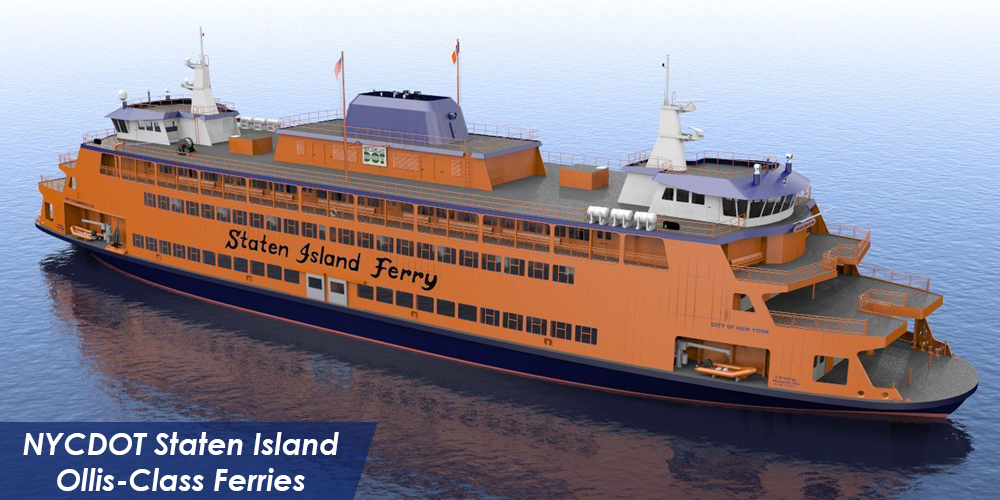 Over the years Brian has done very well for himself, building fishing boats, ferry boats, oil rig support ships and most recently he won a contract to build a number of USCG cutters. That’s pretty neat and apparently his first military contract.
Over the years Brian has done very well for himself, building fishing boats, ferry boats, oil rig support ships and most recently he won a contract to build a number of USCG cutters. That’s pretty neat and apparently his first military contract. 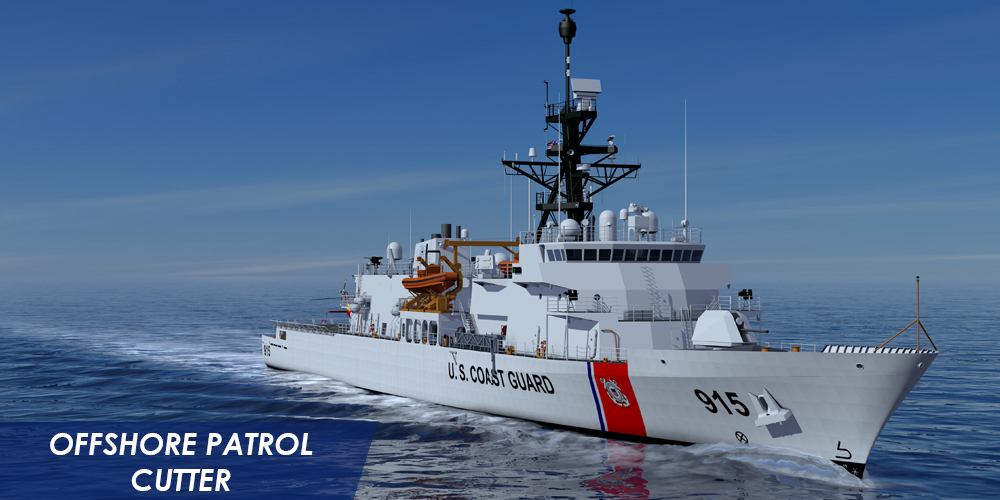 After many years Brian still had that dream to build a replica of Columbia and finally realized his dream when she was launched in 2014. This photo shows the original Columbia and Brian’s Columbia sailing together. How dey do dat?
After many years Brian still had that dream to build a replica of Columbia and finally realized his dream when she was launched in 2014. This photo shows the original Columbia and Brian’s Columbia sailing together. How dey do dat?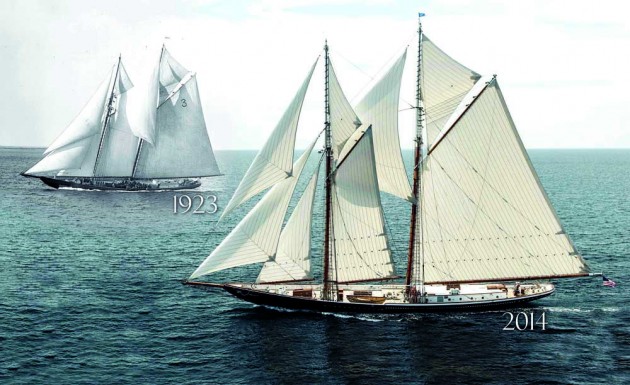 Anyway, all of this is background for my chance visit aboard Columbia when I was in Antigua. As port captain for the
Anyway, all of this is background for my chance visit aboard Columbia when I was in Antigua. As port captain for the  A while later she participated in the “parade of ships” into historic English Harbor. My buddy Franklin sitting on the starboard side in the stern.
A while later she participated in the “parade of ships” into historic English Harbor. My buddy Franklin sitting on the starboard side in the stern.  On her way out of the harbor. Big boat.
On her way out of the harbor. Big boat.  On the dock in English Harbor, looking regal. Nothing quite like a schooner bow to set the heart a racing.
On the dock in English Harbor, looking regal. Nothing quite like a schooner bow to set the heart a racing. Lovely sweep to her deck. All that blue tape is because she was getting her varnish freshened.
Lovely sweep to her deck. All that blue tape is because she was getting her varnish freshened.  Big forward deck still wet from the morning shower.
Big forward deck still wet from the morning shower.  Serious wheel. True to her heritage complete with her name cast into the rim.
Serious wheel. True to her heritage complete with her name cast into the rim. I was particularly struck by her no-nonsense traveler hardware on the main boom. Huge shackles and a really neat central attachment fitting. Note the leather covers on the shell blocks in the lower right. Beautifully stitched.
I was particularly struck by her no-nonsense traveler hardware on the main boom. Huge shackles and a really neat central attachment fitting. Note the leather covers on the shell blocks in the lower right. Beautifully stitched. An impressive mix of hardware at the main mast.
An impressive mix of hardware at the main mast.  And, of course, classic lignum vite dead-eyes and beautifully served stays.
And, of course, classic lignum vite dead-eyes and beautifully served stays. How about the fitting for the goose neck and the wonderfully machined belaying pins. Note the leather padding under each pin. Nice touch.
How about the fitting for the goose neck and the wonderfully machined belaying pins. Note the leather padding under each pin. Nice touch. The day that I visited they were just cleaning up from racing mode so my shot wasn’t as elegant as this. It’s a stunning spot, a perfect place to enjoy a G&T, I’d say. I’ll take extra lime in mine!
The day that I visited they were just cleaning up from racing mode so my shot wasn’t as elegant as this. It’s a stunning spot, a perfect place to enjoy a G&T, I’d say. I’ll take extra lime in mine!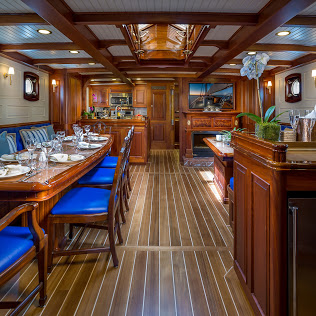 The chef proudly showed me the freezer. Lots of room to keep the crew well fed.
The chef proudly showed me the freezer. Lots of room to keep the crew well fed.  The salon was very comfortable, like a real home. Catch the watertight doors. Really impressive and the boat has a number of watertight bulkheads as she was built to a very high safety standard. How about the tufted leather settee cushions?
The salon was very comfortable, like a real home. Catch the watertight doors. Really impressive and the boat has a number of watertight bulkheads as she was built to a very high safety standard. How about the tufted leather settee cushions? Lovely view forward, complete with watertight bulkheads and the forward mast beautifully varnished. Bummer about the port list. The photographer, not Columbia.
Lovely view forward, complete with watertight bulkheads and the forward mast beautifully varnished. Bummer about the port list. The photographer, not Columbia. It’s hard to get a good shot of the sleeping cabins but I was able to find one from a professional photographer . And, yes, I got permission… I would sleep there! I’d even make my own bed. However, I expect that the Stew wouldn’t approve of my bed making skills, I know Brenda doesn’t.
It’s hard to get a good shot of the sleeping cabins but I was able to find one from a professional photographer . And, yes, I got permission… I would sleep there! I’d even make my own bed. However, I expect that the Stew wouldn’t approve of my bed making skills, I know Brenda doesn’t.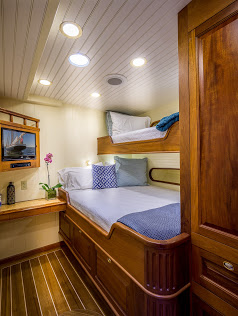 Of course, what’s a schooner without fishing dories? These competed in the Gig Races in English Harbor and did well, I expect. I understand that the were built in Nova Scotia very recently.
Of course, what’s a schooner without fishing dories? These competed in the Gig Races in English Harbor and did well, I expect. I understand that the were built in Nova Scotia very recently. So, there you have it. A boy with a dream and a man who fulfilled that dream.
So, there you have it. A boy with a dream and a man who fulfilled that dream. Montauk light. Almost home.
Montauk light. Almost home.  Visibility was closing in by the mile.
Visibility was closing in by the mile. The closer to shore we got the thicker the fog. The Orient Point ferry emerged ominously from the low hanging fog bank off of New London.
The closer to shore we got the thicker the fog. The Orient Point ferry emerged ominously from the low hanging fog bank off of New London.  Nearly there, the mouth of the CT River.
Nearly there, the mouth of the CT River.  The last time I passed this point was the third week of October, last year.
The last time I passed this point was the third week of October, last year.  After nearly 4,000 miles under Pandora’s keel since passing this point last fall and 9 days since leaving Antigua, we were home and none the worse for wear.
After nearly 4,000 miles under Pandora’s keel since passing this point last fall and 9 days since leaving Antigua, we were home and none the worse for wear. We pulled the top of the sail through the front of the dodger so we could work on it under cover.
We pulled the top of the sail through the front of the dodger so we could work on it under cover.  After a lot of discussion on what the best fix would be, we decided to drill holes in the sail and thread lengths of super-strong Dynema rope to support it. Good thing I have a large tool and spare parts selection aboard.
After a lot of discussion on what the best fix would be, we decided to drill holes in the sail and thread lengths of super-strong Dynema rope to support it. Good thing I have a large tool and spare parts selection aboard.  Several hours, nine holes and a bunch of knots later…
Several hours, nine holes and a bunch of knots later… All done. Not beautiful but plenty strong.
All done. Not beautiful but plenty strong.  The “better side”.
The “better side”.  George and Bob put the sail back into the mast slides as I was still feeling a bit shaky from my run up the mast.
George and Bob put the sail back into the mast slides as I was still feeling a bit shaky from my run up the mast.  And, speaking of my time “aloft”, I had a few bruises to prove that it was a rough ride. This one was particularly tender. Not sure what I banged into but I thought that it was pretty impressive.
And, speaking of my time “aloft”, I had a few bruises to prove that it was a rough ride. This one was particularly tender. Not sure what I banged into but I thought that it was pretty impressive.  The inside of both thighs from clinging to the mast. “Thanks for sharing Bob! Disgusting, really!”
The inside of both thighs from clinging to the mast. “Thanks for sharing Bob! Disgusting, really!”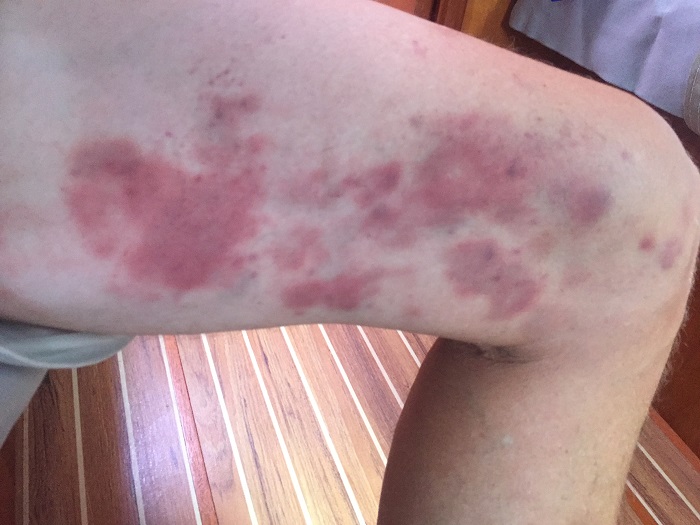 Ok, if you insist. The insides of both arms. I was really clutching the mast with all my might. Superman I’m not, but I was clutching the mast “super hard”.
Ok, if you insist. The insides of both arms. I was really clutching the mast with all my might. Superman I’m not, but I was clutching the mast “super hard”. 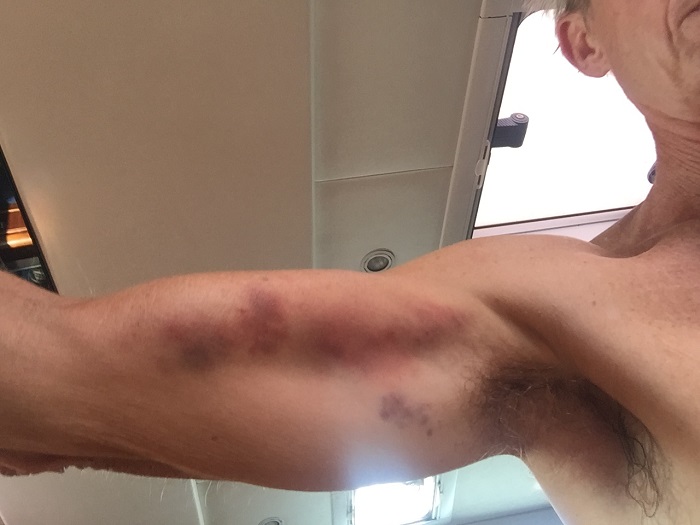 As rough as it was the day I went up the mast, a few days later, not so rough. Once you get north of Bermuda the winds are all over the place if there is any wind at all.
As rough as it was the day I went up the mast, a few days later, not so rough. Once you get north of Bermuda the winds are all over the place if there is any wind at all.  We ended up motoring something like 100 hours and yet still managed to sail between 800 and 900 miles and sometimes at near double digit speeds for days at a time. I wrote about
We ended up motoring something like 100 hours and yet still managed to sail between 800 and 900 miles and sometimes at near double digit speeds for days at a time. I wrote about  One of them slowly swam toward Pandora until he/she was only about 2′ from our hull and suddenly realized how close we were. And with a violent splash, turned away. They really look primeval.
One of them slowly swam toward Pandora until he/she was only about 2′ from our hull and suddenly realized how close we were. And with a violent splash, turned away. They really look primeval. 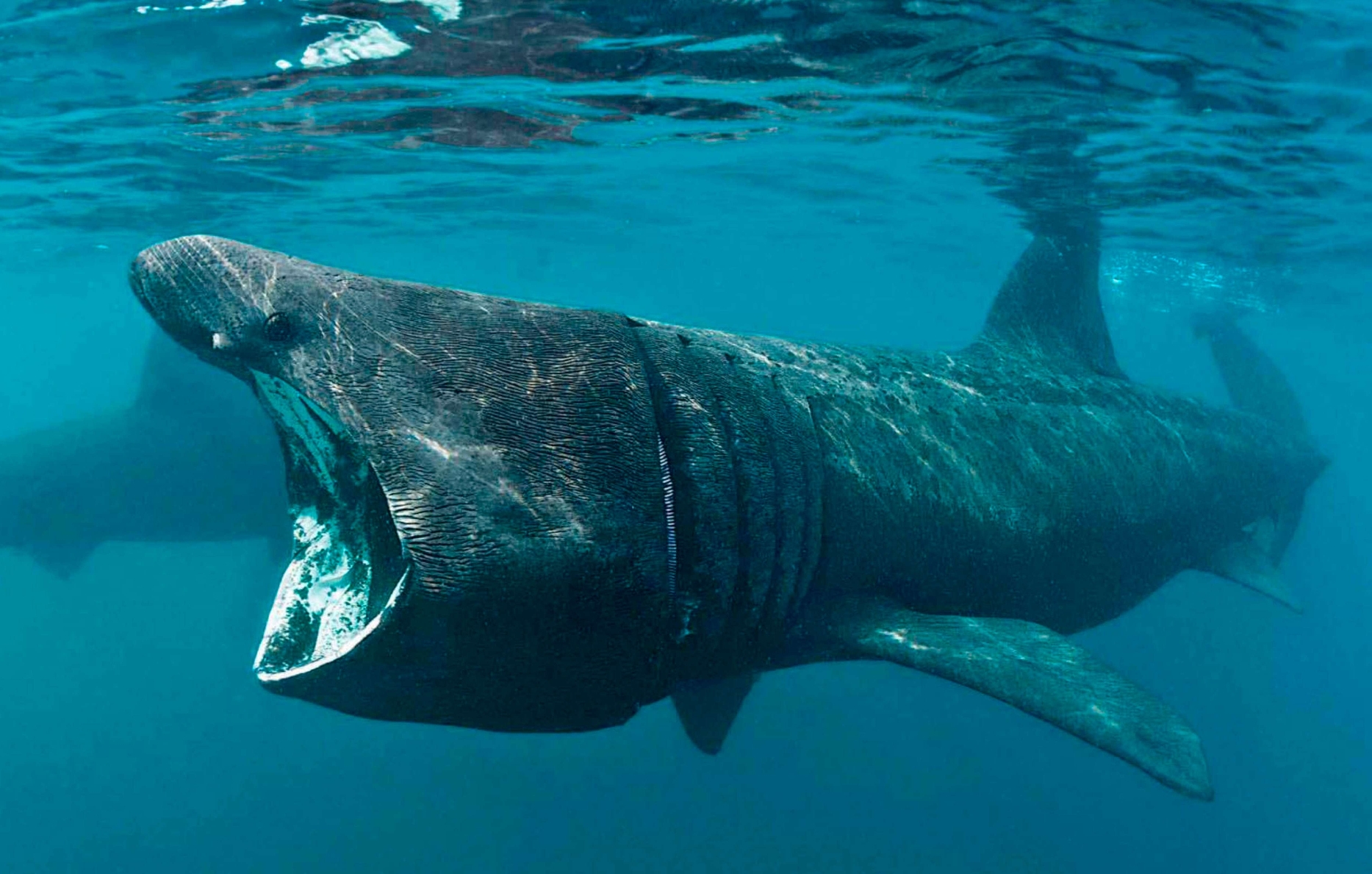 All and all, we had a good run and in spite of 100 hours of motoring, we still made very good time, nearly 180 miles per day for 1,600 miles, over the bottom.
All and all, we had a good run and in spite of 100 hours of motoring, we still made very good time, nearly 180 miles per day for 1,600 miles, over the bottom.